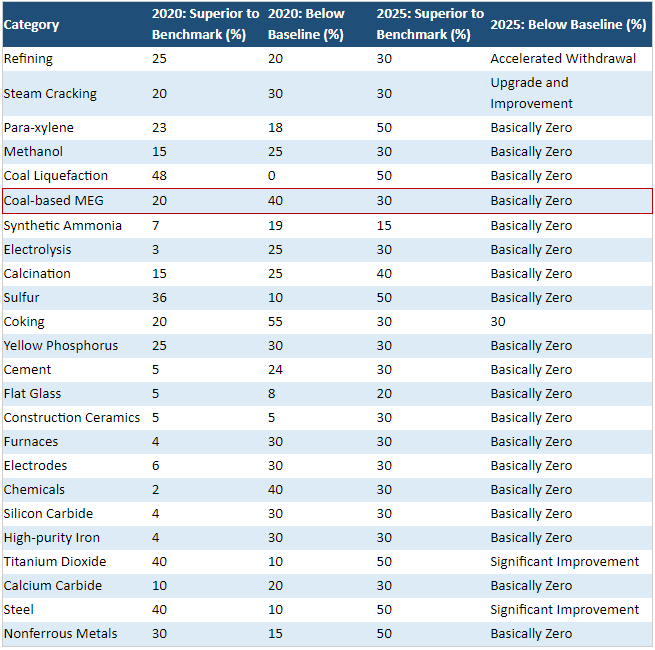Impact of the State Council's "2024-2025 Energy Conservation and Carbon Reduction Action Plan" on Coal-Based Ethylene Glycol
Policy Requirements:
The policy mandates the enhancement of clean and efficient coal utilization, the promotion of low-carbon transformation and construction of coal-fired power, and the advancement of energy-saving, carbon-reducing, and flexible transformations of coal power. It strictly enforces total coal consumption control in key regions for air pollution prevention, primarily reducing non-electric coal usage, continuously shutting down and integrating coal-fired boilers, replacing industrial kilns with clean energy, and managing scattered coal. New and expanded coal projects in key air pollution prevention regions must implement coal use substitution or reduction by law. The policy aims to reasonably control the scale of the semicoke (blue coke) industry. By the end of 2025, scattered coal use in key air pollution prevention regions' plain areas should be nearly zero, and all coal-fired boilers and facilities with a capacity of 35 steam tons/hour or less should be eliminated.
In 2024, the energy consumption and carbon dioxide emissions per unit of GDP are expected to decrease by approximately 2.5% and 3.9%, respectively. Energy consumption per unit of added value for industrial enterprises above designated size should decrease by about 3.5%, with the share of non-fossil energy consumption reaching approximately 18.9%. Energy-saving and carbon-reduction transformations in key areas and industries are expected to achieve energy savings equivalent to about 50 million tons of standard coal and reduce carbon dioxide emissions by about 130 million tons.
Market Reaction:
The policy has increased the capital market's attention to related products, leading to a notable rise in coal-based product prices. From the perspective of coal-based MEG, the policy has minimal impact on the industry, with no substantial effect on most enterprises. The analysis is as follows:
1. Policy Targets:
The policy aims for 30% of domestic coal-based MEG to surpass the benchmark level by 2025, with the proportion below the baseline level being nearly zero. Considering the current market situation, generally, joint production units and MEG units with a single capacity exceeding 400,000 tons have low energy consumption. It can be assumed that all units commissioned after 2022, including those producing with tail gas and clean gas, can meet the benchmark level. These capacities total over 4 million tons, representing 40% of the current syngas-based MEG capacity, effectively meeting the policy's requirement of surpassing the benchmark level by 30%.

2. Baseline Level:
This needs to be explained in two parts. First, the market is concerned about whether there are still coal-based MEG units in operation that have not yet reached the baseline level and what the proportion is. Currently, over 95% of operating coal-based units can meet the baseline level, such as Yangmei Shouyang, HNEC Yongcheng, and Yankuang Rongxin. It can be said that the policy's target of nearly zero below-baseline levels has been basically achieved. Second, the baseline level is essentially an industry entry standard for new units but has little substantial significance for existing operational units. The complete elimination of backward capacities in the industry awaits technological breakthroughs rather than mandatory orders for existing operational units. This differs from previous coal-to-gas boiler conversions in polyester plants, which occurred when new technological breakthroughs were available.
3. Industry Benchmark:
According to the petrochemical association's evaluations of coal-based MEG enterprises over the past two years, some enterprises with capacities below 300,000 tons/year commissioned before the end of 2020 have also been selected as benchmark enterprises.
Conclusion:
We believe that over 90% of the currently operating coal-based MEG enterprises have no issues, and the policy's impact on the industry's supply side can be largely ignored.
- Top keywords
- Cotton Price
- Cotton Futures Price
- Cotton Futures
- CZCE
- PTA Futures Price
- Chemical Fiber
- Polyester Prices
- Wool price
- PTA Futures
- Shengze Silk
- China
- Yarn Price
- price
- China Textile City
- Fibre Price
- Benzene Price
- Cotton
- Index
- Cotton Index
- PTA
- fabric price
- NYMEX
- Top 10
- textile industry
- Spot Cotton
- Cotton Yarn
- Polyester Price
- Futures
- PTA Price
- cotton yarn price

